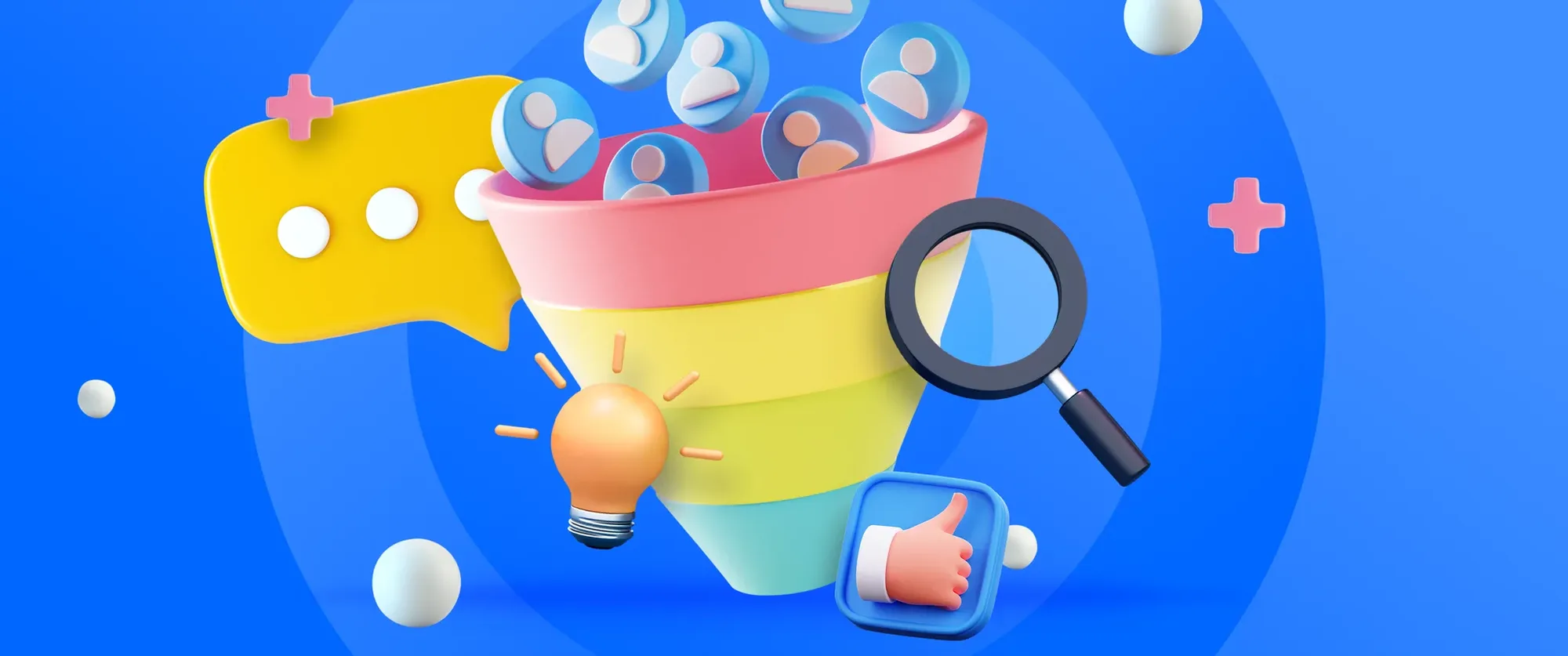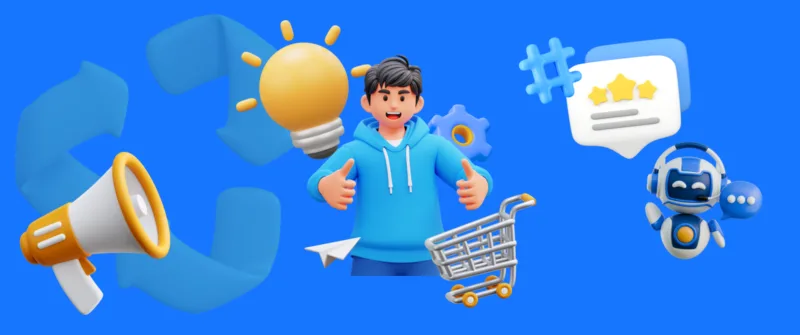Conversion is the transition from one stage to another towards the finality, a bit like the transformation of a caterpillar into a butterfly. In the digital context, conversion involves the process by which a user turns into a qualified lead or customer.
But how do we achieve this conversion? What journey should users take to become a customer ultimately? Are there approaches that are more effective than others?
This is what we will explore in this article dedicated to the art of conversion.
What exactly is conversion?
It has, therefore, been ruled that business conversion is transforming a prospect or visitor into a customer, generally through a specific action. This may include purchasing a product, subscribing to a newsletter, downloading content, or any predefined action representing an engagement or favourable transaction for the company.
We thus convert the person from the passive state to the active state!
Conversion funnels
A conversion funnel refers to a predefined sequence of steps that website visitors go through to achieve a particular goal. This journey represents users' trajectory from their first interaction with the site to completing the desired action, whether a purchase or submission of a form.
Here is an example of the user journey:
- Arrive on the home page.
- Explore products.
- Select a product.
- Add the product to the cart.
- Proceed to checkout.
- Make a payment.
- Successful conversion.
The critical stages of the conversion funnel
Traffic acquisition
A conversion funnel's essential initial phase is generating traffic, i.e., direct visitors to your website. This step can be accomplished through various means such as organic search, online advertising, social media, or other channels. It represents the crucial starting point of the entire conversion process.
Sensitization
After successfully attracting visitors, the next step is to raise their awareness. At this stage, the goal is to make visitors aware of your brand, products or services. This awareness can be achieved through informative content, campaigns, or social media posts.
Interest
After raising visitors' awareness of your offer, the next phase aims to arouse their interest. You must hold their attention by highlighting the value of what you offer. This could involve product demos, customer testimonials, or educational content aimed at solving their problems.
Decision
At this point, visitors have expressed interest in your offering. Now, they must decide whether to compare different options, read reviews, or request additional information. You must be ready to answer their questions and support them in their decision-making process.
Action
The action stage is the conversion funnel's final and most crucial phase. This is when visitors complete the desired action, whether purchasing on an e-commerce site or completing a form for lead generation. All previous work aims to guide visitors to this defining step.
Best practices for optimizing conversion funnels
Google Analytics should become your best friend! Thanks to it, you can visualize all your conversion statistics and ensure they are optimal.
The home page
The homepage's role is crucial in funnel optimization, as it is often a visitor's first interaction with your site, determining the first impression. Effective homepage design is therefore essential for:
- Direct visitors to the conversion funnel when they arrive on the site.
- Capture their attention by clearly and convincingly presenting what your business offers.
- Create a trusting environment that encourages visitors to explore the site further and take action.
Exploring design best practices is essential to ensure a positive first impression, including visual hierarchy, message clarity, intuitive navigation, strategically positioned calls to action, and engaging visuals.
The homepage serves as the gateway to the entire user experience, and you should not underestimate the impact on your conversion rates.
Products and services page
These pages represent central elements of the conversion funnel for e-commerce sites and those focused on lead generation. They play a decisive role in visitors' decision-making, whether to continue their journey and take action, purchase a product or submit a form.
Here's why these pages are so important:
- Comprehensive and Compelling Information: Providing detailed information, specifications, benefits and high-quality images to help visitors make informed decisions.
- Calls to Action (CTAs): Clear and relevant calls to action to encourage visitors to take the next step, whether adding a product to their cart, requesting a quote, or learning more.
- Objection Management: It is essential to anticipate potential questions or objections from visitors and respond to them persuasively, which may involve customer testimonials, satisfaction guarantees or product comparisons.
- Intuitive navigation: Make sure navigation from these pages to other parts of the site is seamless, allowing visitors to continue their journey without friction.
Calls to action (CTAs)
They play a crucial role within a conversion funnel because they actively encourage visitors to take a specific action.
Effective CTA design is of central importance in funnel optimization for the following reasons:
- Visibility: CTAs must be visible and stand out on the page to attract visitors' attention.
- Clarity: CTAs should be clear and specific, stating what the user will get when they click.
- Strategic location: CTAs should be where visitors are most likely to decide to take action based on their journey through the site.
- Colour and Contrast: Use appropriate colours and contrast to make CTAs stand out while respecting the site's colour palette.
- Mobile-friendliness: Make sure CTAs are just as effective on mobile devices by scaling them to smaller screen sizes.
The goal of thoughtful CTA design is to encourage visitors to take action. A compelling CTA can, therefore, play an essential role in the conversion process, transforming simple visitors into engaged customers or prospects.
A/B testing
What is A/B testing?
A/B testing represents an invaluable strategy for the continuous improvement of conversion funnels. This method involves creating two versions (A and B) of a page, form or CTA, changing only one element to determine which version has the best conversion results.
How to do an A/B test
A/B testing on an existing website can significantly optimize conversion, user engagement, and overall performance.
Here are the steps to follow to perform such a test:
Step 1: Define your goals
Start by clearly identifying what you want to improve on your website. Is it to increase conversion rates, improve usability, reduce bounce rate, or achieve other specific goals?
Step 2: Identify what to test
Select the elements you want to test on your website, such as headlines, images, call-to-action buttons, forms, colours, layout, messages, etc.
Step 3: Choose an A/B testing tool
Among the many A/B testing platforms and tools available on the market, such as Sitecore Personalize, VWO testing, Unbounce (among the favourites of our team of experts!) and others, choose the one that best suits your needs and your budget.
Step 4: Create your variations
For each item you want to test, create different variations. For example, if you're testing CTA button text, build variation A with the original text and variation B with the edited text you want to test.
Step 5: Split the Traffic
Using your chosen A/B testing tool, set up a test that splits traffic between variations A and B of the page or element you're testing.
Step 6: Let the test run
Allow the test to run for a sufficient period to collect a meaningful data sample.
Step 7: Analyze the results
Once testing is complete, analyze the data to determine which variation performed best against your goals.
Step 8: Apply Best Practices
Use the test results to improve your website by permanently implementing the winning variation or continuing testing to refine it.
Step 9: Repeat the process
Conclusion
Converting customers may seem daunting, but remember, it’s worth its weight in gold! The benefits you will subsequently see will justify the investment. If you would like more information on the subject, do not hesitate to contact our team of specialists, who will be happy to answer your questions.






